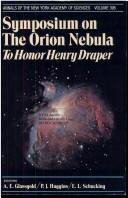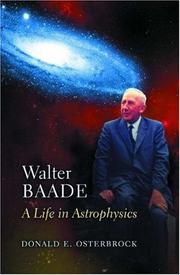| Listing 1 - 7 of 7 |
Sort by
|
Book
Year: 1959 Publisher: Asiago,
Abstract | Keywords | Export | Availability | Bookmark
 Loading...
Loading...Choose an application
- Reference Manager
- EndNote
- RefWorks (Direct export to RefWorks)
ORION NEBULA --- ATLASES --- Orion Nebula.
Book
Year: 1986 Publisher: Los Angeles, Calif. : [Washington, D.C.]: University of California, Dept. of Astronomy ; [National Aeronautics and Space Administration],
Abstract | Keywords | Export | Availability | Bookmark
 Loading...
Loading...Choose an application
- Reference Manager
- EndNote
- RefWorks (Direct export to RefWorks)
Astronomical models. --- IUE. --- Mathematical models. --- Orion nebula.
Book
ISBN: 3540519564 354046865X 0387519564 Year: 1989 Publisher: Berlin Springer
Abstract | Keywords | Export | Availability | Bookmark
 Loading...
Loading...Choose an application
- Reference Manager
- EndNote
- RefWorks (Direct export to RefWorks)
Galaxies --- Interstellar matter --- Molecular clouds --- Stars --- Congresses. --- Formation --- Münch Paniagua, Guido, --- Orion Nebula

ISBN: 089766180X 0897661818 9780897661812 9780897661805 Year: 1982 Volume: 395 Publisher: New York (N.Y.): New York academy of sciences
Abstract | Keywords | Export | Availability | Bookmark
 Loading...
Loading...Choose an application
- Reference Manager
- EndNote
- RefWorks (Direct export to RefWorks)
Stars --- Astrophysicists --- Etoiles --- Biography --- Congresses --- Formation --- Congrès --- Draper, Henry, --- Orion Nebula --- Festschrift - Libri Amicorum --- Congrès --- Mammals --- Zoohistology. Zoocytology --- Stars - Formation - Congresses --- Draper, Henry, - 1837-1882 - Congresses --- Orion Nebula - Congresses --- Draper, Henry, - 1837-1882

ISBN: 069104936X Year: 2001 Publisher: Oxford : Princeton University Press,
Abstract | Keywords | Export | Availability | Bookmark
 Loading...
Loading...Choose an application
- Reference Manager
- EndNote
- RefWorks (Direct export to RefWorks)
Although less well known outside the field than Edwin Hubble, Walter Baade was arguably the most influential observational astronomer of the twentieth century. Written by a fellow astronomer deeply familiar with Baade and his work, this is the first biography of this major figure in American astronomy. In it, Donald Osterbrock suggests that Baade's greatest contribution to astrophysics was not, as is often contended, his revision of Hubble's distance and age scales for the universe. Rather, it was his discovery of two distinct stellar populations: old and young stars. This discovery opened wide the previously marginal fields of stellar and galactic evolution--research areas that would be among the most fertile and exciting in all of astrophysics for decades to come. Baade was born, educated, and gained his early research experience in Germany. He came to the United States in 1931 as a staff member of Mount Wilson Observatory, which housed the world's largest telescope. There, he pioneered research on supernovae. With the 100-inch telescope, he studied globular clusters and the structure of the Milky Way, every step leading him closer to the population concept he discovered during the wartime years, when the skies of southern California were briefly darkened. Most Mount Wilson astronomers were working on weapons-development crash programs devoted to bringing Baade's native country to its knees, while he, formally an enemy alien in their midst, was confined to Los Angeles County but had almost unlimited use of the most powerful telescope in the world. After his great discovery, Baade continued his research with the new 200-inch telescope at Palomar. Always respected and well liked, he became even more famous among astronomers as they shifted their research to the fields he had opened. Publicity-shy and seemingly unconcerned with publication, however, Baade's celebrity remained largely within the field. This accomplished biography at last introduces Baade--and his important work--to a wider public, including the newest generation of skywatchers.
Astrophysicists --- Baade, Walter, --- Adams, Walter S. --- Agfa photographic company. --- Allegheny Observatory. --- Astronomical Journal. --- Baade Telescope. --- Baade, Katherine (sister). --- Bergedorf. --- Biermann, Ludwig. --- Boyden Station. --- Case Institute of Technology. --- Comet Baade. --- Einstein, Albert. --- Fermi, Enrico. --- Fornax system. --- Fricke, Walter. --- Ganymede. --- Gaustad, John. --- Göttingen Observatory. --- Hale telescope. --- Hamburg Observatory. --- Harvard College Observatory. --- Hitler, Adolf. --- Hoyle, Fred. --- Hubble constant. --- Hund, Friedrich. --- Icarus. --- Institute for Advanced Study. --- Institute for Experimental Aerodynamics. --- Jansky, Karl. --- Jena University. --- Johnson, Harold L. --- Johnson, Josef. --- Kienle, Hans. --- Klein, Felix. --- Kuiper, Gerard P. --- Laporte, Otto. --- Leiden Observatory. --- Lick Observatory. --- Lund University. --- Mason, Max. --- Minkowski, Hermann. --- Nazi party. --- Orion nebula. --- Pulkovo Observatory. --- Ross lens. --- Schorr, Richard. --- Scientific American. --- cosmology. --- eclipsing binaries. --- globular clusters. --- interstellar extinction. --- radio sources.
Book
ISBN: 0691223610 9780691223612 Year: 2021 Publisher: Princeton, New Jersey : Princeton University Press,
Abstract | Keywords | Export | Availability | Bookmark
 Loading...
Loading...Choose an application
- Reference Manager
- EndNote
- RefWorks (Direct export to RefWorks)
A pocket-style edition distilled from the New York Times bestsellerAwaiting you in this breezy book is a whirlwind tour through the cosmos-a journey of exploration to other planets, stars, and galaxies, and from black holes to time loops. With acclaimed astrophysicists Neil deGrasse Tyson, Michael A. Strauss, and J. Richard Gott at your side, here you will find a brief and yet breathtaking introduction to the universe, which will help you in your quest to understand how the cosmos actually works.A Brief Welcome to the Universe propels you from our home solar system to the outermost frontiers of space, building your cosmic insight and perspective through a marvelously entertaining narrative. How do stars live and die? What are the prospects of intelligent life elsewhere in the universe? How did the universe begin? Why is it expanding and accelerating in the process? Is our universe alone or part of an infinite multiverse? Exploring these and many other questions, this pocket-friendly book is your passport into the wonders of our evolving cosmos.
Astrophysics --- Cosmology --- Astronomical physics --- Astronomy --- Cosmic physics --- Physics --- Accelerating expansion of the universe. --- Accretion (astrophysics). --- Alpha particle. --- Andromeda Galaxy. --- Angular diameter. --- Astrobiology. --- Astrophysics. --- Atomic nucleus. --- Barred spiral galaxy. --- Big Bang. --- Calculation. --- Chemical element. --- Chronology of the universe. --- Circumference. --- Copernican principle. --- Cosmic Background Explorer. --- Cosmic microwave background. --- Cosmic string. --- Cosmogony. --- Dark energy. --- De Sitter space. --- Deuterium. --- Dimension. --- Earth. --- Einstein field equations. --- Elementary particle. --- Elliptic orbit. --- Energy density. --- Event horizon. --- Exoplanet. --- Extraterrestrial life. --- Galactic Center. --- Galactic year. --- Galaxy cluster. --- Googol. --- Gravitational wave. --- Gravity. --- Hawking radiation. --- Hubble Space Telescope. --- Hubble's law. --- Inflation (cosmology). --- Interstellar medium. --- Irregular galaxy. --- Jim Peebles. --- Jupiter. --- Kepler (spacecraft). --- Kuiper belt. --- Light-year. --- Longevity. --- Luminosity. --- Main sequence. --- Measurement. --- Metric expansion of space. --- Milky Way. --- Molecule. --- Neutron star. --- Neutron. --- Newton's law of universal gravitation. --- Nitrogen. --- Nuclear fusion. --- Nuclear reaction. --- Observable universe. --- Orion Nebula. --- Photon. --- Physicist. --- Planck (spacecraft). --- Planetary habitability. --- Planetary nebula. --- Positron. --- Prediction. --- Pressure. --- Quantity. --- Quantum tunnelling. --- Quasar. --- Real Humans. --- Red giant. --- Result. --- Satellite galaxy. --- Saturn. --- Shape of the universe. --- Solar System. --- Solar mass. --- Spacecraft. --- Spiral galaxy. --- Star. --- Supernova. --- Temperature. --- The Astrophysical Journal. --- The Pluto Files. --- Thermal radiation. --- Universe Today. --- Universe. --- Uranus. --- Vacuum energy. --- Vacuum state. --- Wavelength. --- Weakly interacting massive particles. --- Welcome to the Universe. --- White dwarf. --- Year. --- SCIENCE / Physics / Astrophysics --- SCIENCE / Physics / General
Book
ISBN: 0691239460 Year: 2002 Publisher: Princeton, New Jersey : Princeton University Press,
Abstract | Keywords | Export | Availability | Bookmark
 Loading...
Loading...Choose an application
- Reference Manager
- EndNote
- RefWorks (Direct export to RefWorks)
The solar system has always been a messy place in which gravity wreaks havoc. Moons form, asteroids and comets crash into planets, ice ages commence, and dinosaurs disappear. By describing the dramatic consequences of such disturbances, this authoritative and entertaining book reveals the fundamental interconnectedness of the solar system--and what it means for life on Earth. After relating a brief history of the solar system, Alan Rubin describes how astronomers determined our location in the Milky Way. He provides succinct and up-to-date accounts of the energetic interactions among planetary bodies, the generation of the Earth's magnetic field, the effects of other solar-system objects on our climate, the moon's genesis, the heating of asteroids, and the origin of the mysterious tektites. Along the way, Rubin introduces us to the individual scientists--including the famous, the now obscure, and the newest generation of researchers--who have enhanced our understanding of the galactic neighborhood. He shows how scientific discoveries are made; he discusses the uncertainty that presides over the boundaries of knowledge as well as the occasional reluctance of scientists to change their minds even when confronted by compelling evidence. This fresh historical perspective reveals science as it is: an imperfect but self-correcting enterprise. Journeying to the frontiers of knowledge, Rubin concludes with the exciting realm of astrobiology. He chronicles the history of the search for life on Mars and describes cutting-edge lines of astrobiological inquiry, including panspermia (the possible transfer of life from planet to planet), the likelihood of technologically advanced alien civilizations in our galaxy, and our probable responses to alien contact. Authoritative and up-to-date but also entertaining and fluidly written, Disturbing the Solar System will appeal to any reader who has ever picked up a rock or gazed at the moon with a sense of wonder.
Life on other planets. --- Gravity. --- Catastrophes (Geology) --- Accretion (astrophysics). --- Antimatter. --- Aristarchus (crater). --- Astrobiology. --- Astronomer. --- Astronomy. --- Astrophysics. --- Binary star. --- Canyon Diablo (meteorite). --- Carbon dioxide. --- Carbonaceous chondrite. --- Chondrite. --- Chondrule. --- Comet. --- Cosmic Background Explorer. --- Cosmic dust. --- Cosmic ray. --- Crater chain. --- Debris disk. --- Discovery and exploration of the Solar System. --- Earth's magnetic field. --- Exoplanet. --- Extinction event. --- Extraterrestrial life. --- Formation and evolution of the Solar System. --- Galactic Center. --- Geologist. --- Giant planet. --- Giant-impact hypothesis. --- Gravity anomaly. --- Heliocentrism. --- Hubble Space Telescope. --- Impact crater. --- Impact event. --- Impact structure. --- Incompatible element. --- Iridium anomaly. --- Iron meteorite. --- Jupiter. --- Kara crater. --- Lunar eclipse. --- Lunar mare. --- Lunar meteorite. --- Magnetic anomaly. --- Magnetic field. --- Magnetosphere. --- Martian meteorite. --- Mesosiderite. --- Meteor Crater. --- Meteor shower. --- Meteorite. --- Meteoroid. --- Microorganism. --- Molecular cloud. --- Moon rock. --- Nebular hypothesis. --- Neutron star. --- Nuclear explosion. --- Nuclear fusion. --- Nuclear reaction. --- Occultation. --- Oort cloud. --- Orbit. --- Orbital eccentricity. --- Orbital period. --- Origin of the Moon. --- Orion Nebula. --- Panspermia. --- Planet. --- Planetary body. --- Planetary nebula. --- Planetary surface. --- Planetary system. --- Planetesimal. --- Polarity reversal (seismology). --- Projectile. --- Radiation damage. --- Radiation pressure. --- Radioactive decay. --- Radionuclide. --- Rings of Saturn. --- Rubble pile. --- Runaway greenhouse effect. --- Saturn. --- Sediment. --- Shock metamorphism. --- Silicate. --- Small Solar System body. --- Solar System. --- Solar eclipse. --- Solar flare. --- Solar mass. --- Spacecraft. --- Spiral galaxy. --- Supernova. --- Tektite. --- Uranus. --- Urey (crater). --- Van Allen radiation belt. --- Volcanism.
| Listing 1 - 7 of 7 |
Sort by
|

 Search
Search Feedback
Feedback About
About Help
Help News
News